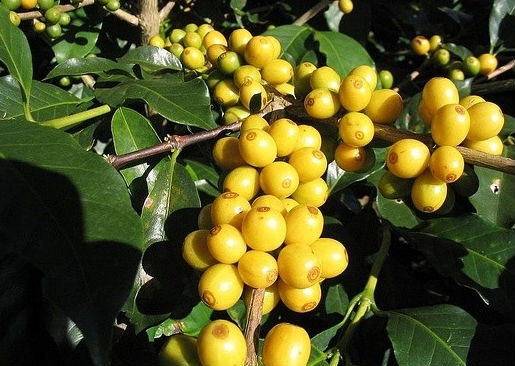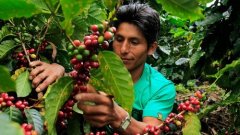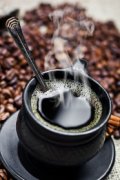A brief introduction to the origin, development, history and culture of El Qomolangma boutique coffee beans.

El Salvador produces 100% Arabica coffee, of which 68% is Bourbon, Coffea arabica var. Bourbon), 29% Pacas, other varieties including Pacamara,Caturra, etc.
The Pacas variety, first discovered in El Salvador in 1949, is a natural hybrid between bourbon and Catura.
The variety Pacamara, which was artificially bred by pacas and maragogipe (or maragogype), was first bred in 1958 (1954). Pacamara species is a rare artificial breeding of excellent varieties, blue is better than blue, perfectly inheriting the advantages of the mother plant, both the excellent taste of pacas species, raw bean granules also inherited the large size of malagogipe. The Pacamara species is thought to be the result of the pursuit of large Arabica species.
Coffee planting
Most of them are planted by small farmers. Grading of farmers in El Salvador: (1 htct= 105mu = 10000 square meters)
Small farmers, small producer, area less than 7.0hect
Medium-sized peasant household, medium producer, area between 7. 0-70hect
Large farmers, large producer, the area is larger than 70hect.
Farmers use traditional planting methods, with almost 100% shade planting.
Coffee harvest
Pick by hand.
The harvest season lasts from October to March. The peak occurs from November to February.
Charat Nango production area is famous for its outstanding performance in coe events this year. A few years ago, chalatenango was unknown, and some farmers in the area began to grow Pacamara in the 1990s. In 2006, a small farm in the region played in coe with pacamara and won the runner-up in the race with a fascinating flavor. In 2007, several farms in the area took part in the competition with pacamara. As a result, they won the first, third and fourth places, and became famous in the pacamara of chalatenango and ta. The producing area is located in the Altotepec Metagan mountain system in the north, which is the purple area at the top of the image above.
Flavor and quality of coffee
El Salvador is a producer of high-quality commercial Arabica beans and is known for its strict and effective quality control.
Since 2003, he has joined the COE competition.
With excellent ancient coffee, successfully entered the boutique coffee market.
Coffee flavor is related to the microclimate of the producing area. On the whole, Salvadoran coffee inherits the mild quality of Central American coffee. It is soft, slightly sour and has beautiful sweetness, so it is suitable for blending.
Boutique Salvadoran coffee can also be impressive, including some pacamara varieties, which show active acidity, layered and deep taste, and a long finish.
Coffee organization
UCAFES:Organization of coffee producity cooperatives of el salvador, accounting for 25% of the total output
UCRAPROBEX:Organization of Land Reform Coffee Producing & Processing Cooperatives, including small farmers without land before the land reform, accounted for 10% of the total output.
ABECAFE:Association of millers and Coffee Exporters, including 99 processing plants and most exporters
The Association of Coffee Producers of El Salvador represents all coffee producers.
The above four coffee organizations, plus four national research institutes, constitute a coffee policy-making body--
The Salvadoran Coffee Association Consejo Salvadoreno del cafe (salvador coffee concil), which is involved in coffee promotion, data collection and international cooperation.
Coffee variety
The civil war caused chaos and affected economic development, but ironically allowed the ancient coffee to be preserved, and the situation was so chaotic that coffee producers in El Salvador failed to catch up with the renewal of coffee varieties in Central and South America.
Important Notice :
前街咖啡 FrontStreet Coffee has moved to new addredd:
FrontStreet Coffee Address: 315,Donghua East Road,GuangZhou
Tel:020 38364473
- Prev

A brief introduction to the description of the flavor, taste and aroma characteristics of El Qomolangma boutique coffee beans
El Salvador boutique coffee is concentrated in the volcanic rock producing areas of Santa Ana in the west and Charantanan fruit in the northwest. In recent years, the top 10 cup tests are almost entirely from these two producing areas, with an altitude of about 9-1500 meters, mainly bourbon (68%). Followed by Pacas (29%), mixed-race Pakamara, Dulaai and Kaddura accounted for only 3%. The coffee harvest season has been held since November.
- Next

A brief introduction to the planting Market Price of El Qomolangma Fine Coffee Bean varieties with Light and aromatic body
In Cuscacbapa, El Salvador, coffee beans that have been packaged are about to be exported. Coffee from El Salvador is a specialty of Central America, where it is light, fragrant, pure and slightly sour. Like Guatemala and Costa Rica, coffee in El Salvador is graded according to altitude, and the higher the altitude, the better the coffee. The best brand is Pip
Related
- Detailed explanation of Jadeite planting Land in Panamanian Jadeite Manor introduction to the grading system of Jadeite competitive bidding, Red bid, Green bid and Rose Summer
- Story of Coffee planting in Brenka region of Costa Rica Stonehenge Manor anaerobic heavy honey treatment of flavor mouth
- What's on the barrel of Blue Mountain Coffee beans?
- Can American coffee also pull flowers? How to use hot American style to pull out a good-looking pattern?
- Can you make a cold extract with coffee beans? What is the right proportion for cold-extracted coffee formula?
- Indonesian PWN Gold Mandrine Coffee Origin Features Flavor How to Chong? Mandolin coffee is American.
- A brief introduction to the flavor characteristics of Brazilian yellow bourbon coffee beans
- What is the effect of different water quality on the flavor of cold-extracted coffee? What kind of water is best for brewing coffee?
- Why do you think of Rose Summer whenever you mention Panamanian coffee?
- Introduction to the characteristics of authentic blue mountain coffee bean producing areas? What is the CIB Coffee Authority in Jamaica?

